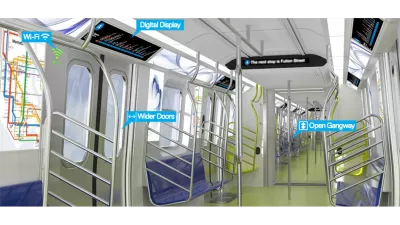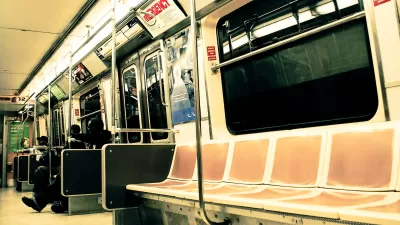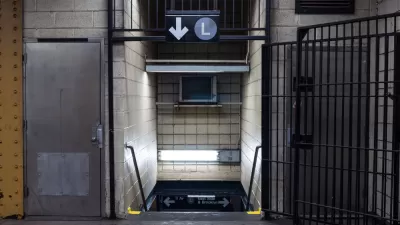Some of the New York Subway's stations and cars could be getting a drastically updated look—as soon as 2020.

"On Monday, New York Governor Andrew Cuomo unveiled details of a $27-billion redesign plan" for the New York Subway, reports Tanvi Misra.
The five-year expansion plan would add "1,025 new subway cars with a variety of new features: wider doors, LED headlights, digital signage, USB chargers, seats that flip up, and wi-fi." Of that number of new cars, "750 cars will have an “open gangway” design, meaning that commuters will be able to move freely along the length of cars on an accordion-like train."
Features like open gangways and wider doors can directly improve the subway's service performance. As noted by Misra, "[t]he point of many of these changes is to fit more passengers inside the cars, and allow for swifter flows between the train and the platform. Both of these goals, if achieved, would help reduce wait times for trains and overcrowding in subway stations."
USB chargers and Wi-Fi, however, fall into a category of improvement noted by a recent TransitCenter study as superfluous to the concerns of many transit users.
The article includes renderings of the new cars, which are loosely scheduled for a 2020 arrival date. The pan also includes renderings and proposals for the renovation of 31 stations around all five boroughs.
FULL STORY: A Peek Inside New York's Subway Redesign Plan

Planetizen Federal Action Tracker
A weekly monitor of how Trump’s orders and actions are impacting planners and planning in America.

Map: Where Senate Republicans Want to Sell Your Public Lands
For public land advocates, the Senate Republicans’ proposal to sell millions of acres of public land in the West is “the biggest fight of their careers.”

Restaurant Patios Were a Pandemic Win — Why Were They so Hard to Keep?
Social distancing requirements and changes in travel patterns prompted cities to pilot new uses for street and sidewalk space. Then it got complicated.

Platform Pilsner: Vancouver Transit Agency Releases... a Beer?
TransLink will receive a portion of every sale of the four-pack.

Toronto Weighs Cheaper Transit, Parking Hikes for Major Events
Special event rates would take effect during large festivals, sports games and concerts to ‘discourage driving, manage congestion and free up space for transit.”

Berlin to Consider Car-Free Zone Larger Than Manhattan
The area bound by the 22-mile Ringbahn would still allow 12 uses of a private automobile per year per person, and several other exemptions.
Urban Design for Planners 1: Software Tools
This six-course series explores essential urban design concepts using open source software and equips planners with the tools they need to participate fully in the urban design process.
Planning for Universal Design
Learn the tools for implementing Universal Design in planning regulations.
Heyer Gruel & Associates PA
JM Goldson LLC
Custer County Colorado
City of Camden Redevelopment Agency
City of Astoria
Transportation Research & Education Center (TREC) at Portland State University
Camden Redevelopment Agency
City of Claremont
Municipality of Princeton (NJ)





























